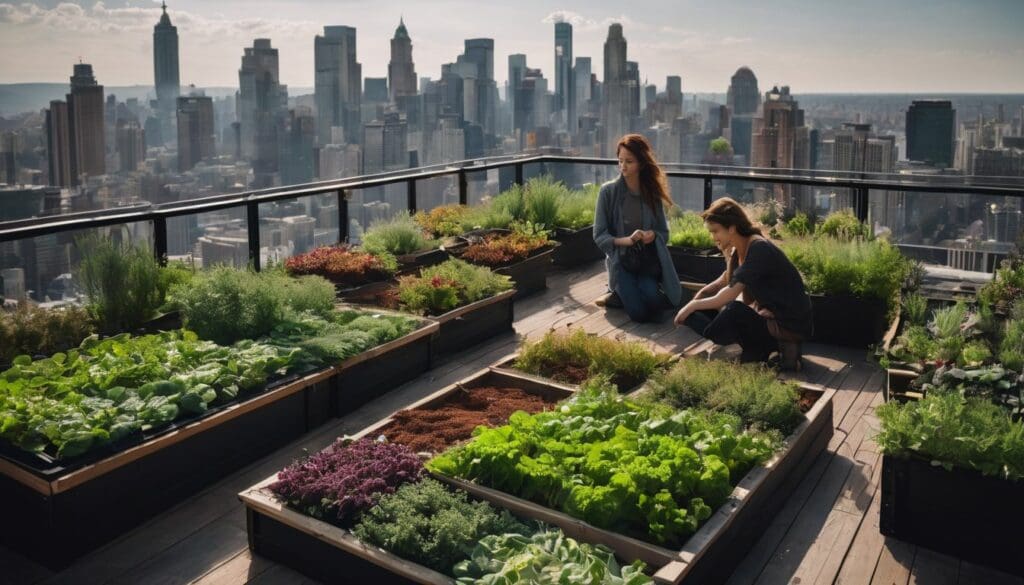Are you looking to reduce your carbon footprint and grow food right where you live? Urban homesteading transforms city spaces into productive havens, blending modern living with traditional skills.
Our guide provides practical steps to cultivate a sustainable lifestyle amidst the urban hustle. Dive in for green inspiration!
Key Takeaways
- Urban homesteading is a self – reliant way of life in cities that combines modern living with traditional skills, aiming to reduce carbon footprints and promote sustainability.
- Despite challenges like limited space and strict city regulations, urban homesteaders use creative methods such as vertical gardening and community engagement to overcome these obstacles.
- Starting an urban homestead can be simple; grow food in containers, learn DIY skills, join local groups for support, and comply with relevant laws to successfully adapt to this eco-friendly lifestyle.
- Engaging with the urban homesteading community is beneficial for sharing resources, gaining knowledge, and working together on projects that enhance sustainable living in urban areas.
- By practising sustainable urban homesteading, individuals contribute positively to their immediate environment and global ecological health through reduced dependence on industrial production.
What is Urban Homesteading?
Urban Homesteading is the practice of self-reliant living in an urban setting, focusing on sustainable living and eco-friendly practices. It has its origins in the back-to-the-land movement and has transitioned to urban areas as people seek a more environmentally conscious lifestyle.
Meaning and origins
Urban Homesteading combines the ethos of sustainable living with urban settings. People embracing this movement aim for self-reliance by growing organic food, practising scratch cooking, and preserving food right where they live – in the city.
This modern twist on homesteading has its roots in the back-to-the-land movement that gained momentum during the 1960s and 1970s. It was a time when people hungered for a simpler life, one deeply connected with nature.
Today’s urban homesteaders draw inspiration from heirloom skills once common in rural communities. They’re transforming balconies, rooftops and vacant lots into verdant spaces for urban gardening and permaculture projects.
By doing so, they marry traditional knowledge with eco-conscious living to cultivate localised lifestyles amidst skyscrapers and bustling city streets. These pioneers are reshaping our understanding of what it means to live sustainably within an urban landscape.
Transition to urban areas
As people move into urban areas, they are increasingly interested in sustainable living. Urban homesteading allows individuals to embrace self-reliance, eco-friendly practices, and community involvement within a city environment.
The shift from rural to urban settings has led to the development of new initiatives such as urban farming, community gardening, renewable energy projects, and green building designs.
This transition reflects a growing commitment to localised living and environmentally conscious choices.
Benefits of Urban Homesteading
Urban homesteading promotes localisation, self-reliance, and an environmentally friendly lifestyle. This sustainable way of living allows individuals to reduce their carbon footprint and live more in harmony with nature.
Localisation and self-reliance
Urban homesteading promotes localisation and self-reliance. By growing your own food, raising livestock, and generating renewable energy locally, you reduce reliance on external resources and contribute to a more sustainable lifestyle.
This shift towards self-sufficiency minimises the environmental impact of transportation and diminishes dependence on mass-produced goods. Embracing eco-conscious living fosters community resilience in the face of global challenges, while promoting a back-to-the-land movement that benefits both individuals and the environment.
Embracing urban homesteading encourages greater self-reliance by producing essential resources within your local environment. This promotes a reduced ecological footprint by decreasing reliance on industrial methods of production that often contribute to pollution and resource depletion.
Environmentally friendly lifestyle
Creating an environmentally friendly lifestyle is essential for sustainable urban homesteading. By embracing eco-conscious living, individuals can reduce their ecological footprint and contribute to the overall health of the planet.
This involves practising self-sufficiency, minimising waste, and supporting localised production and consumption.
Embracing an environmentally friendly lifestyle also entails a commitment to conservation efforts, such as reducing energy consumption, promoting biodiversity, and adopting eco-friendly practices in everyday life.
Challenges of Urban Homesteading
Limited space and strict rules and regulations often pose challenges for those looking to start their urban homestead. However, with creativity and determination, these obstacles can be overcome to create a sustainable and self-sufficient lifestyle in an urban setting.
Limited space
Urban homesteading faces the challenge of limited space in densely populated cities. Despite this, creative solutions such as vertical gardens, rooftop beekeeping, and small-space composting have enabled urban homesteaders to maximise their available area for sustainable living practices.
By utilising every inch efficiently, individuals can cultivate a vibrant urban oasis that supports eco-friendly living and self-sufficiency within a confined setting.
In response to constraints posed by limited space, urban homesteaders have embraced innovative techniques like container gardening and hydroponic systems. These methods allow for conservation and environmental impact beyond what might seem possible in an urban environment.
Rules and regulations
To pursue sustainable urban homesteading, it’s important to understand the rules and regulations that apply in your area. These regulations can dictate what activities are allowed on your property, which may impact how you plan and manage your urban homestead.
It’s crucial to familiarise yourself with local bylaws related to gardening, livestock keeping, water usage, and waste management. Seek out community resources or workshops where you can learn about zoning laws and city ordinances that pertain to sustainable living practices.
Familiarising yourself with the rules and regulations will help ensure that you establish an environmentally friendly lifestyle within legal parameters while promoting self-reliance in a confined space.
How to Start Your Urban Homestead
To start your urban homestead, begin by growing your own produce in containers or small garden plots. Get involved in local community gardens and seek out resources for sustainable living practices.
Tips for beginners
- Start small with easy-to-grow vegetables like salad greens, herbs, and tomatoes.
- Utilise vertical gardening to make the most of limited space.
- Consider composting to reduce waste and create nutrient-rich soil for your plants.
- Research local regulations on keeping chickens or bees for fresh eggs and honey.
- Join a community garden or urban homesteading group for support and shared resources.
- Learn basic DIY skills for repairs and creating homemade products.
- Invest in energy – efficient appliances and explore renewable energy options for your home.
Importance of community
When beginning your urban homesteading journey, it’s essential to recognise the value of community. Engaging with like-minded individuals provides a support system for sharing knowledge and resources, fostering a sense of belonging within the sustainable living movement.
Community involvement enables collaboration on local projects promoting self-sufficiency and eco-conscious living, reinforcing the significance of collective action in achieving environmental goals.
Building relationships within your community fosters an environment where ideas are exchanged freely, creating opportunities for learning and growth. Through shared experiences and collective efforts, communities can work together towards sustainable urban homesteading practices that benefit both individuals and the environment as a whole.
Conclusion
In conclusion, sustainable urban homesteading offers a path towards environmentally friendly living. It empowers individuals to embrace self-reliance in urban settings. By fostering community and embracing eco-conscious practices, urban homesteading presents an opportunity for positive change.
As more people explore this lifestyle, the potential for widespread impact on local environments and sustainability grows.
FAQs
1. What is sustainable urban homesteading?
Sustainable urban homesteading is a lifestyle that promotes self-reliance and eco-conscious living in an urban setting, focusing on being eco-friendly and practising self-sufficiency.
2. How can I start with urban homesteading?
You begin by adopting practices that contribute to localisation and sustainability, like growing your own food or reducing waste, reflecting the back-to-the-land movement but in a city environment.
3. Can you save money with sustainable urban homesteading?
Yes, you can save money as eco-conscious living encourages using less and maximising resources, which often leads to spending less on everyday expenses.
4. Is it possible to be fully self-sufficient in the city?
While complete self-sufficiency might be challenging in an urban area, you can aim for semi-self-sufficiency by combining modern conveniences with traditional methods of the back-to-the-land movement.





